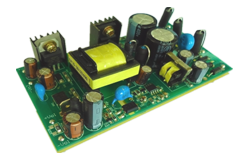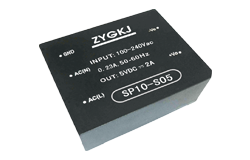nouvelles
Efficient 110V AC to 12V DC Converter for Seamless Power Supply
Auteur: Module d'alimentation ZYG Time: 2023-5-20
In today’s world, electronic devices have become an integral part of our lives. From the smartphones that we carry with us to the laptops that we use for work, we rely heavily on these devices to stay connected and get things done. However, to power these devices, we need a reliable and efficient power supply.
One of the most important components of any power supply system is the voltage converter. A voltage converter is a device that converts the voltage of an electrical circuit from one level to another. In this article, we will discuss the efficient 110V AC to 12V DC converter, which is an essential component of many power supply systems.
What is a 110V AC to 12V DC Converter?
A 110V AC to 12V DC converter is a device that converts the alternating current (AC) voltage from a power outlet into a direct current (DC) voltage of 12 volts. This device is commonly used to power electronic devices that require a 12V DC power supply, such as LED lights, CCTV cameras, and car audio systems.
How Does a 110V AC to 12V DC Converter Work?
A 110V AC to 12V DC converter works by using a transformer to convert the alternating current (AC) voltage from the power outlet into a lower voltage level. This lower voltage level is then rectified and filtered to produce a smooth DC voltage of 12 volts.
The transformer in the converter consists of two coils of wire, the primary coil, and the secondary coil. When AC voltage is applied to the primary coil, it creates an alternating magnetic field. This magnetic field induces a voltage in the secondary coil, which is then rectified and filtered to produce a smooth DC voltage of 12 volts.
Efficiency of a 110V AC to 12V DC Converter
The efficiency of a 110V AC to 12V DC converter refers to the amount of power that is lost during the conversion process. A more efficient converter will lose less power and, therefore, provide a more stable and reliable power supply.
There are several factors that can affect the efficiency of a converter, including the quality of the transformer, the quality of the rectifier, and the quality of the filter capacitors. It is important to choose a converter that is designed with high-quality components to ensure maximum efficiency and reliability.
Advantages of a 110V AC to 12V DC Converter

There are several advantages to using a 110V AC to 12V DC converter in a power supply system. One of the main advantages is that it provides a stable and reliable power supply that is essential for powering electronic devices. Additionally, these converters are small and lightweight, making them easy to install and transport.
Another advantage of using a 110V AC to 12V DC converter is that it is more efficient than traditional linear power supplies. This efficiency results in less power loss and lower operating costs, making it a more cost-effective solution for powering electronic devices.
Conclusion
A 110V AC to 12V DC converter is an essential component of many power supply systems. It provides a stable and reliable power supply for electronic devices that require a 12V DC power supply. When choosing a converter, it is important to select one that is designed with high-quality components to ensure maximum efficiency and reliability. With the right converter, you can ensure seamless power supply for all your electronic devices.
Précédent: Efficient AC-DC Converter for Automobiles
Prochain: High-Powered AC to DC Converter: 12V 15 Amp for Reliable Performance
les informations pertinentes
-
2023-6-2
Bidirectional DC DC Converter: A Solution for Efficient Power Transfer
In today's world, power electronics is playing a vital role in all aspects of our life. Power electronics refers to the control and conversion of electrical power from one form to another using electronic devices. One of the most important applications of power electronics is power conversion, where electrical power is converted from one form to another, such as AC to DC or DC to AC. In this context, bidirectional DC DC converters have gained significant attention in recent years due to their ability to transfer power efficiently between two DC systems. What is a Bidirectional DC DC Converter? A bidirectional DC DC converter is a power electronic circuit that allows power to flow in both directions between two DC...
Voir les détails -
2022-7-26
How to choose a reliable China DC-DC power supplier
DC means direct current. DC current is defined as unidirectional current. In a DC current, electrons move from a region of negative charge to a region of positive charge without any change in direction. This state persists despite alternating current, in which current can move in both directions. DC can pass through conductive and semiconducting materials. Electricity is defined as the flow of electrons through a conductor such as a wire. Current builds up in two ways, alternating and direct. The main difference between AC and DC current is the direction of electron movement. DC-DC is realized with the idea of switching power supply. There are two types of DC-DC, buck and boost, which are called buck here. For example,...
Voir les détails -
2023-6-26
120V AC to 12V DC Converter: Efficient Conversion for Your Electrical Needs
Are you tired of constantly replacing batteries or struggling to find a power source for your devices? Look no further than a 120V AC to 12V DC converter. This handy device allows you to convert the standard household voltage of 120V AC to the lower voltage of 12V DC. This opens up a world of possibilities for powering devices such as LED lights, fans, radios, and even small appliances. One of the biggest advantages of a 120V AC to 12V DC converter is its efficiency. The conversion process itself is highly efficient, with most converters boasting a conversion rate of at least 90%. This means that very little energy is wasted in the conversion process, making it a more sustainable...
Voir les détails -
2023-8-7
120V AC to 12V DC Converter: Efficiently Powering Your Devices with Ease
Introduction In this fast-paced digital era, we heavily rely on various electronic devices to fulfill our everyday tasks. From smartphones and laptops to gaming consoles and kitchen appliances, these devices have become an integral part of our lives. However, the majority of them require a direct current (DC) power supply to operate efficiently. This is where a 120V AC to 12V DC converter comes into play. In this article, we will explore the benefits and applications of this converter, highlighting how it efficiently powers your devices with ease. Understanding the Basics Let us start by understanding the basics of electrical power and the difference between alternating current (AC) and direct current (DC). AC is the standard power supplied by the...
Voir les détails -
2023-5-4
Design and Development of an Industrial AC-DC Converter
Introduction Industrial AC-DC converters are essential components in modern power electronics systems. They convert alternating current (AC) power from the grid to direct current (DC) power for use in various industrial applications. The design and development of an efficient industrial AC-DC converter require a thorough understanding of power electronics principles and a careful selection of components to ensure optimal performance. This article discusses the essential steps involved in the design and development of an industrial AC-DC converter. Step 1: Determine the Specifications The first step in the design process is to determine the specifications of the industrial AC-DC converter. The specifications should include the input voltage and frequency, output voltage and current, power rating, and efficiency requirements. These specifications will...
Voir les détails -
2023-5-27
Choose China 12V 15A AC to DC Converter Manufacturer
A 12V 15A AC to DC Converter is a device that can be used to convert AC voltage into DC voltage. AC stands for Alternating Current, while DC stands for Direct Current. The process of converting AC to DC involves rectification, filtering, and regulation. The rectification process involves converting the AC voltage into a pulsing DC voltage. This is done by using a diode bridge, which is a circuit that consists of four diodes arranged in a bridge configuration. The diodes allow the current to flow in only one direction, which results in a pulsing DC voltage. The next step is filtering. The pulsing DC voltage is not suitable for most electronic devices, as it contains ripples and fluctuations. To...
Voir les détails


















